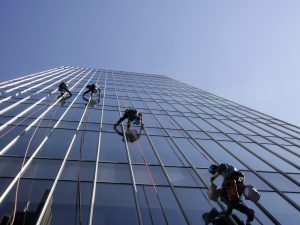A description of the strength and safety of suspended scaffolds
How much more can we do? Will more standards increase the safety of suspended scaffolds? Will training increase the safety of suspended scaffolds? Will more safety features increase the safety of suspended scaffolds? Wait—is there a problem that needs to be addressed or are suspended scaffolds safe? It is always interesting when I first meet someone and tell them I am involved with scaffolding. Sooner rather than later they tell me how dangerous it all must be and how could I still be alive? And when I tell them that a properly constructed scaffold, including one hanging down the side of a building by ropes is completely safe, they just insist that I must not know what I am talking about.
If you look at the statistics, they are correct; unfortunately they missed the word “properly” when I say that a properly constructed suspended scaffold is safe. The injury and fatality statistics do indicate that there are issues with scaffolds, particularly suspended scaffolds, those scaffolds that have “one or more platforms suspended by ropes or other non-rigid means from an overhead structure.” A commonly seen example is the scaffold platform that is used by workers to perform maintenance to the face of a high rise building. And of course, it is also commonly seen on the evening television news when there is a scaffold failure—it makes great footage for the local and national news crews.
I thought it would be an educational exercise to see how many US federal OSHA scaffold standards specifically address and/or require safety items for a typical single or two point suspended scaffold. There are four primary components of a suspended scaffold, the rigging, the platform, the hoist, and the personnel safety protection. Each of these components has requirements that go beyond the basic function of that component. For example, the rope that the platform hangs from is much stronger than what is required to support the load. This is called the safety factor; its purpose is to make sure that the scaffold doesn’t collapse because an errant worker damaged the suspension rope while using the scaffold. So, here is the list I came up with—can you add to it?
Rigging: 6 to 1 safety factor on the rope (wow that is high!); 4 to 1 safety factor on the beams and counterweights (that’s high too!); Design by a qualified person; Installation under the supervision of a competent person; A tieback rope to hold the rigging in position and not let it slide off the roof; non-flowable counterweight; For multi-point suspended scaffolds, the design to be completed by a qualified Professional Engineer; When it is secured directly to the structure it shall be evaluated by a competent person; Counterweights shall be secured to the outrigger beam; Ropes shall be inspected before each workhshift (Actually the whole scaffold shall be inspected before each workshift); 3 wire rope clips shall be used (instead of the normal 2 required for rigging materials);
Platform: The normal width shall not exceed 36 inches; The fasteners securing the platform to the hoist shall have a 4 to 1 safety factor; The platform shall have a 4 to 1 safety factor; The platform shall not swing (In spite of the fact that we sometimes call them “swing scaffolds”); A guardrail system shall be installed on all open sides of the platform.
Hoist: The rope shall be long enough or have a stop so the end of the rope doesn’t pass through the hoist; The hoist shall be tested by a qualified testing laboratory; The hoist shall have an operating over-speed brake; The hoist shall have a 4 to 1 safety factor.
Personnel Protection: All occupants shall wear and utilize proper personal fall protection. The anchor for the vertical lifeline shall be independent of the scaffold rigging; The lifeline anchor shall hold 5,000 pounds or be designed by a qualified person to have a 2 to 1 safety factor; The employer shall provide for prompt rescue of employees in the event of a fall or shall assure that employees are able to rescue themselves; The user has to have training in the proper use of the scaffold, including all the safety items.
That’s quite a list. Let’s sum it up: The rigging, hoist and platform have to be really strong. The suspension rope has to be really, really strong. Not only does the platform have to have a guardrail system so the worker doesn’t walk off the platform, but the worker has to utilize personal fall protection so she doesn’t fall in case the platform disappears. In the event of that occurrence, the worker who is hanging around must be promptly rescued. (Yeah, like that always happens—that’s what makes the evening news so interesting. Nobody planned to get the guy down that’s hanging on the side of the building.)
So how can it be that suspended scaffolds fail? Everything has more strength than is required, the workers are trained, the equipment is constantly inspected for defects, and a rescue plan is in place. Perhaps the evening news should be more thorough in its investigation. You figure it out—do we need more rules or do we just have to use the ones we have?












